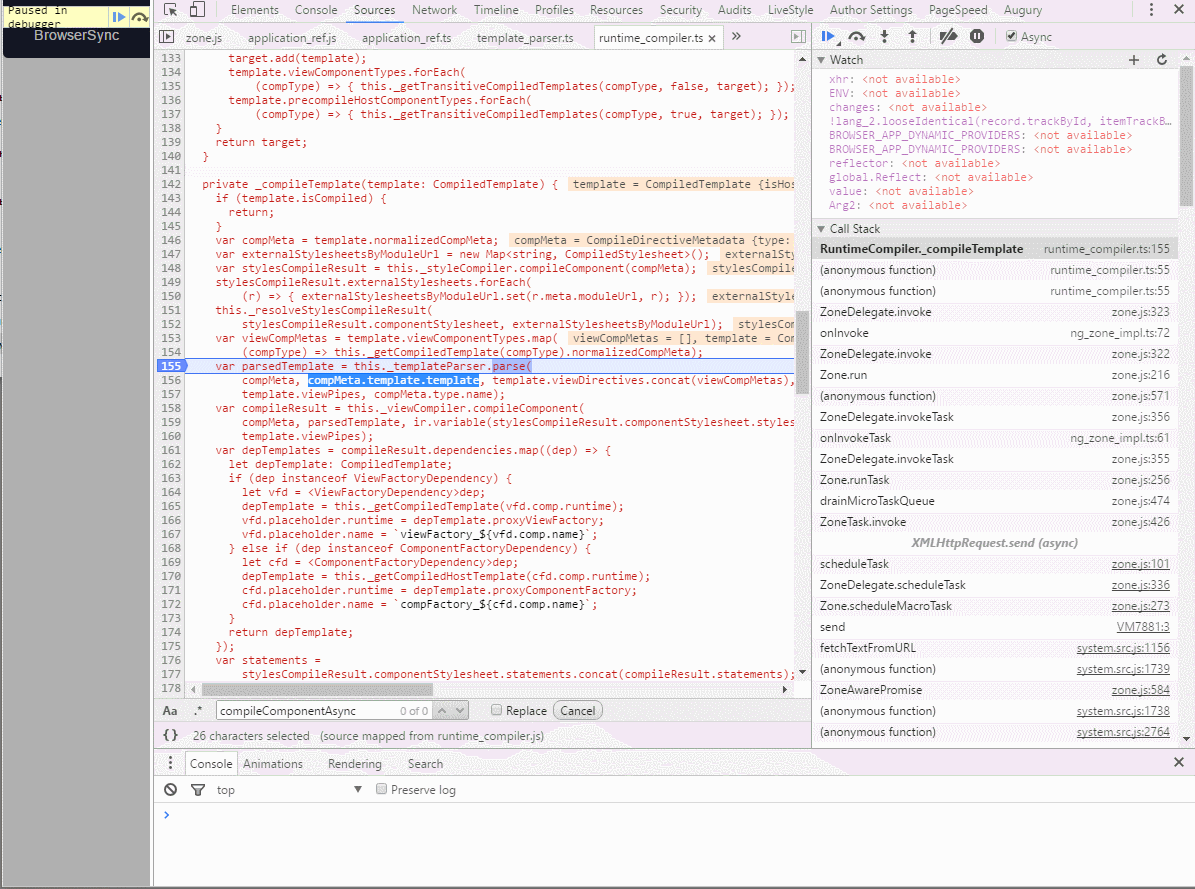是的,所有的魔法都发生在编译器中。
让我们看一下这个模板:
<div *ngFor="let foo of foobars">{{foo}}</div>
首先它将被转换为以下形式:
<div template="ngFor let foo of foobars>{{foo}}</div>
进而:
<template ngFor let-foo [ngForOf]="foobars"><div>{{foo}}</div></template>
In Angular2 rc.4 it looks like this

首先生成 ast 树节点(抽象语法树节点),然后所有的魔法都发生在TemplateParseVisitor.visitElement(https://github.com/angular/angular/blob/2.0.0-rc.4/modules/%40angular/compiler/src/template_parser.ts#L284 https://github.com/angular/angular/blob/2.0.0-rc.4/modules/%40angular/compiler/src/template_parser.ts#L284)特别是在底部(https://github.com/angular/angular/blob/2.0.0-rc.4/modules/%40angular/compiler/src/template_parser.ts#L394 https://github.com/angular/angular/blob/2.0.0-rc.4/modules/%40angular/compiler/src/template_parser.ts#L394)
if (hasInlineTemplates) {
var templateCssSelector = createElementCssSelector(TEMPLATE_ELEMENT, templateMatchableAttrs);
var templateDirectiveMetas = this._parseDirectives(this.selectorMatcher, templateCssSelector);
var templateDirectiveAsts = this._createDirectiveAsts(
true, element.name, templateDirectiveMetas, templateElementOrDirectiveProps, [],
element.sourceSpan, []);
var templateElementProps: BoundElementPropertyAst[] = this._createElementPropertyAsts(
element.name, templateElementOrDirectiveProps, templateDirectiveAsts);
this._assertNoComponentsNorElementBindingsOnTemplate(
templateDirectiveAsts, templateElementProps, element.sourceSpan);
var templateProviderContext = new ProviderElementContext(
this.providerViewContext, parent.providerContext, parent.isTemplateElement,
templateDirectiveAsts, [], [], element.sourceSpan);
templateProviderContext.afterElement();
parsedElement = new EmbeddedTemplateAst(
[], [], [], templateElementVars, templateProviderContext.transformedDirectiveAsts,
templateProviderContext.transformProviders,
templateProviderContext.transformedHasViewContainer, [parsedElement], ngContentIndex,
element.sourceSpan);
}
return parsedElement;
该方法返回EmbeddedTemplateAst。它等同于:
<template ngFor let-foo [ngForOf]="foobars"><div>{{foo}}</div></template>
如果你想转:
<div *myDirective="item">{{item.stuff}}</div>
into
<template myDirective let-item><div>{{item.stuff}}</div></template>
那么你需要使用以下语法:
<div *myDirective="let item">{{item.stuff}}</div>
但在这种情况下,您将不会传递上下文。
您的自定义结构指令可能如下所示:
@Directive({
selector: '[myDirective]'
})
export class MyDirective {
constructor(
private _viewContainer: ViewContainerRef,
private _templateRef: TemplateRef<any>) {}
@Input() set myDirective(prop: Object) {
this._viewContainer.clear();
this._viewContainer.createEmbeddedView(this._templateRef, prop); <== pass context
}
}
你可以这样使用它:
<div *myDirective="item">{{item.stuff}}</div>
||
\/
<div template="myDirective:item">{{item.stuff}}</div>
||
\/
<template [myDirective]="item">
<div>{{item.stuff}}</div>
</template>
我希望这将帮助您了解结构指令的工作原理。
Update:
让我们看看它是如何工作的(plunker https://plnkr.co/edit/myE61PkX7UU4nAmGDQ1x?p=preview)
*dir="let foo v foobars" => [dirV]="foobars"
所以你可以编写以下指令:
@Directive({
selector: '[dir]'
})
export class MyDirective {
@Input()
dirV: any;
@Input()
dirK: any;
ngAfterViewInit() {
console.log(this.dirV, this.dirK);
}
}
@Component({
selector: 'my-app',
template: `<h1>Angular 2 Systemjs start</h1>
<div *dir="let foo v foobars k arr">{ foo }</div>
`,
directives: [MyDirective]
})
export class AppComponent {
foobars = [1, 2, 3];
arr = [3,4,5]
}
这里是对应的Plunker https://plnkr.co/edit/bKbWiUYiGmNh5l3yiUhG?p=preview
See also
- https://angular.io/docs/ts/latest/guide/structural-directives.html#!#the-asterisk-effect https://angular.io/docs/ts/latest/guide/structural-directives.html#!#the-asterisk-effect
- https://teropa.info/blog/2016/03/06/writing-an-angular-2-template-directive.html https://teropa.info/blog/2016/03/06/writing-an-angular-2-template-directive.html
- https://www.bennadel.com/blog/3076-creating-an-index-loop-structural-directive-in-angular-2-beta-14.htm https://www.bennadel.com/blog/3076-creating-an-index-loop-structural-directive-in-angular-2-beta-14.htm
- https://egghead.io/lessons/angular-2-write-a-structural-directive-in-angular-2 https://egghead.io/lessons/angular-2-write-a-structural-directive-in-angular-2
您可以在这里找到实例https://alexzuza.github.io/enjoy-ng-parser/ https://alexzuza.github.io/enjoy-ng-parser/